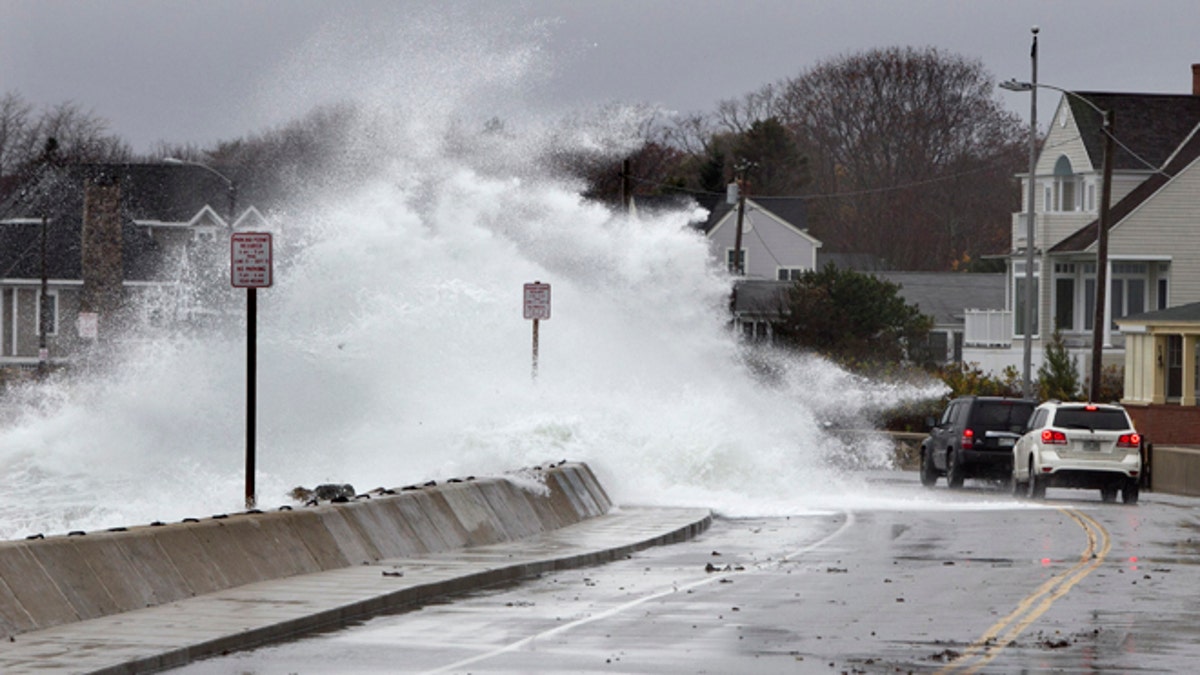
Oct. 29, 2012: Heavy surf crashes over a seawall on the Atlantic Ocean during the early stages of Hurricane Sandy in Kennebunk, Maine. But what caused the massivfe storm? (AP Photo/Robert F. Bukaty)
Sandy soaked the East Coast -- but is global warming to blame?
New York Gov. Andrew M. Cuomo and Mayor Mike Bloomberg told the country in no uncertain terms on Tuesday that devastating superstorm Sandy was clear proof of climate change.
'Anyone who says there's not a dramatic change in weather patterns, I think is denying reality,” Cuomo said in a press conference. "What is clear is that the storms that we've experienced in the last year or so, around this country and around the world, are much more severe than before," Bloomberg agreed.
But scientists say the evidence is far less concrete than the politicians appear to believe.
Martin Hoerling, a meteorologist with the National Oceanic and Atmospheric Administration (NOAA), said Sandy wasn’t boosted by global warming -- the storm merely revealed natural forces at work.
[pullquote]
“Great events can have little causes,” he told the New York Times. “In this case, the immediate cause is most likely little more that the coincidental alignment of a tropical storm with an extratropical storm.”
Indeed, rather than fueling the storm, Hoerling stressed that climate change has little to no effect upon hurricanes.
“Neither the frequency of tropical or extratropical cyclones over the North Atlantic are projected to appreciably change due to climate change, nor have there been indications of a change in their statistical behavior over this region in recent decades,” he said.
Andrew Weaver, a climate scientist with Canada’s University of Victoria, agreed that climate change didn't make an ordinary storm extraordinary.
"The ingredients of this storm seem a little bit cooked by climate change, but the overall storm is difficult to attribute to global warming," Weaver told the Associated Press.
But the science is anything but clear cut. Michael Mann, a Penn State University scientist who has been studying the climate for decades, said that ocean waters were about 1 degree warmer thanks to manmade climate change, one factor that clearly caused Sandy to swell.
Others pressed for policy to deal with global warming, arguing that the such storms are clear proof of man’s effect on the planet -- and we’re in for it in the future.
“The terrifying truth is that America faces a future full of Frankenstorms,” said Shaye Wolf, climate science director at the Center for Biological Diversity. “Climate change raises sea levels and supersizes storms. The threat of killer winds and crushing storm surges will grow by the year unless we get serious about tackling greenhouse gas pollution.”
To further complicate matters, climate scientists and hurricane experts largely conclude that as the climate warms, there will be fewer hurricanes overall, although those that hit will be stronger and wetter, according to the Associated Press.
So why was Sandy such a doozy?
Several factors contributed to the strength of the hurricane, beyond the standard elements that cause the storms to brew up in the tropics: a low-pressure trough dipping from the Arctic, higher tides thanks to a full moon, and a high-pressure system pushing the storm onshore.
"You've got three factors here that have come together in just the right pattern to create a storm of this type," David Robinson, a Rutgers University professor and New Jersey's state climatologist, told LiveScience. "That's why it's very rare."
